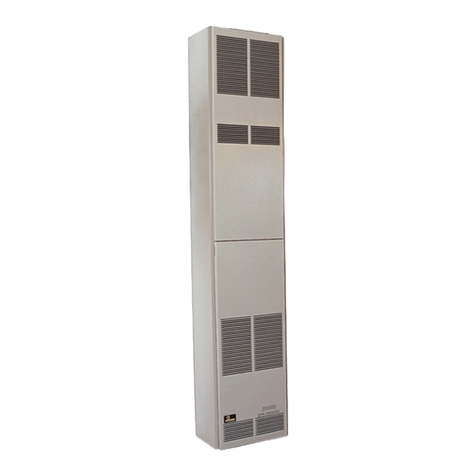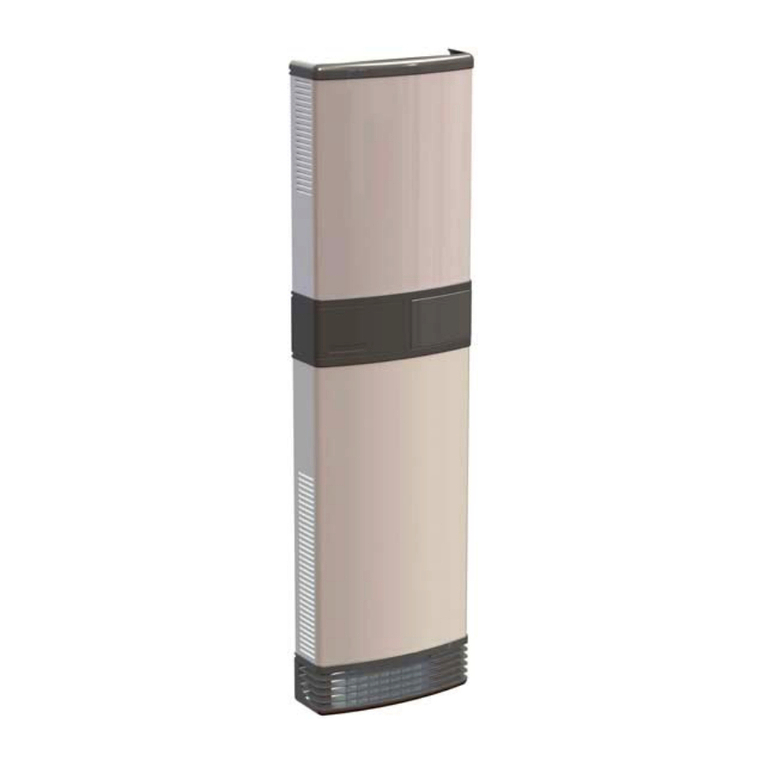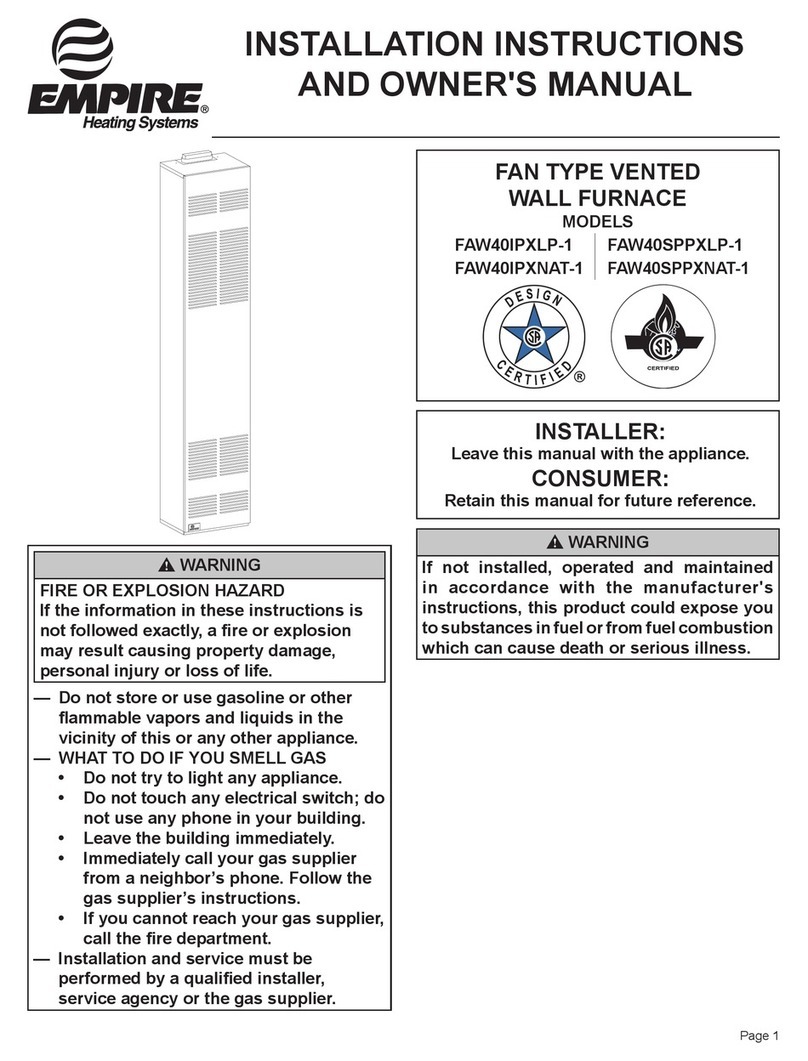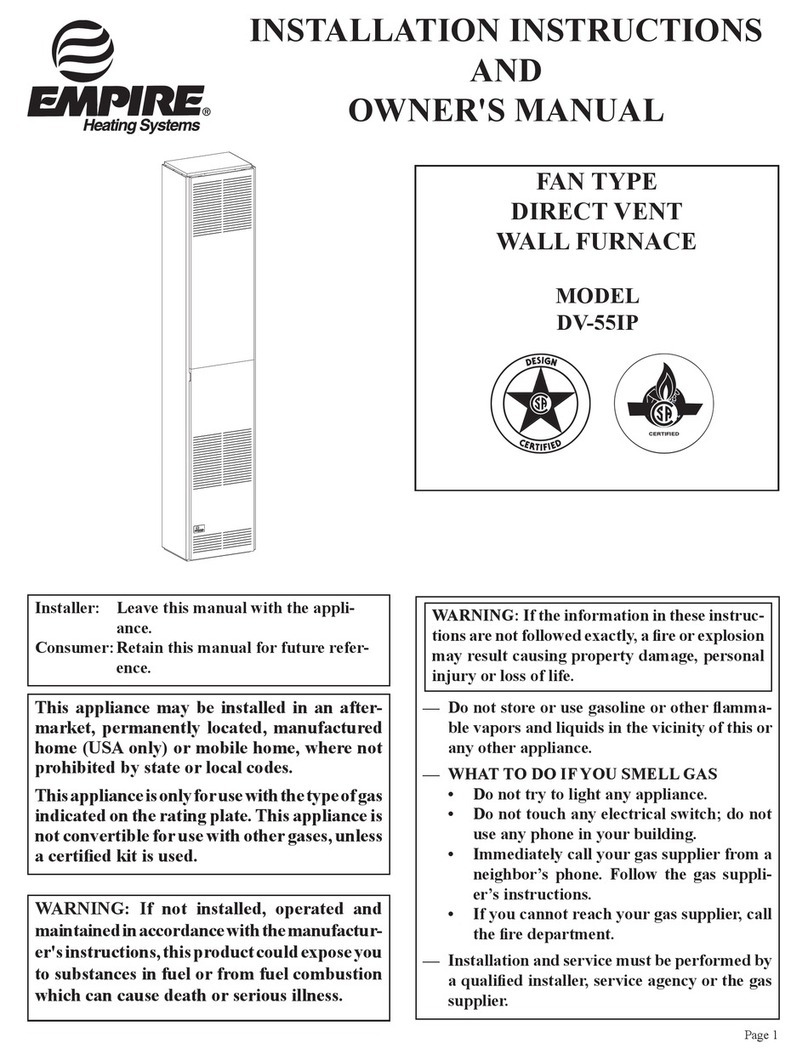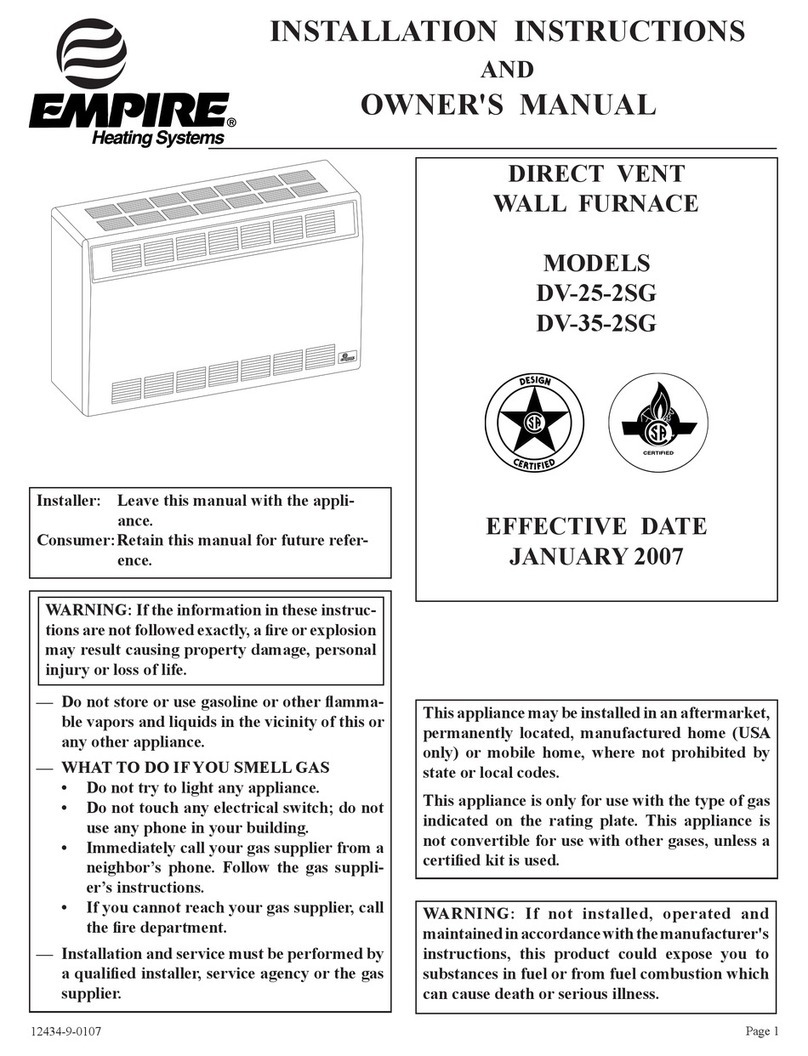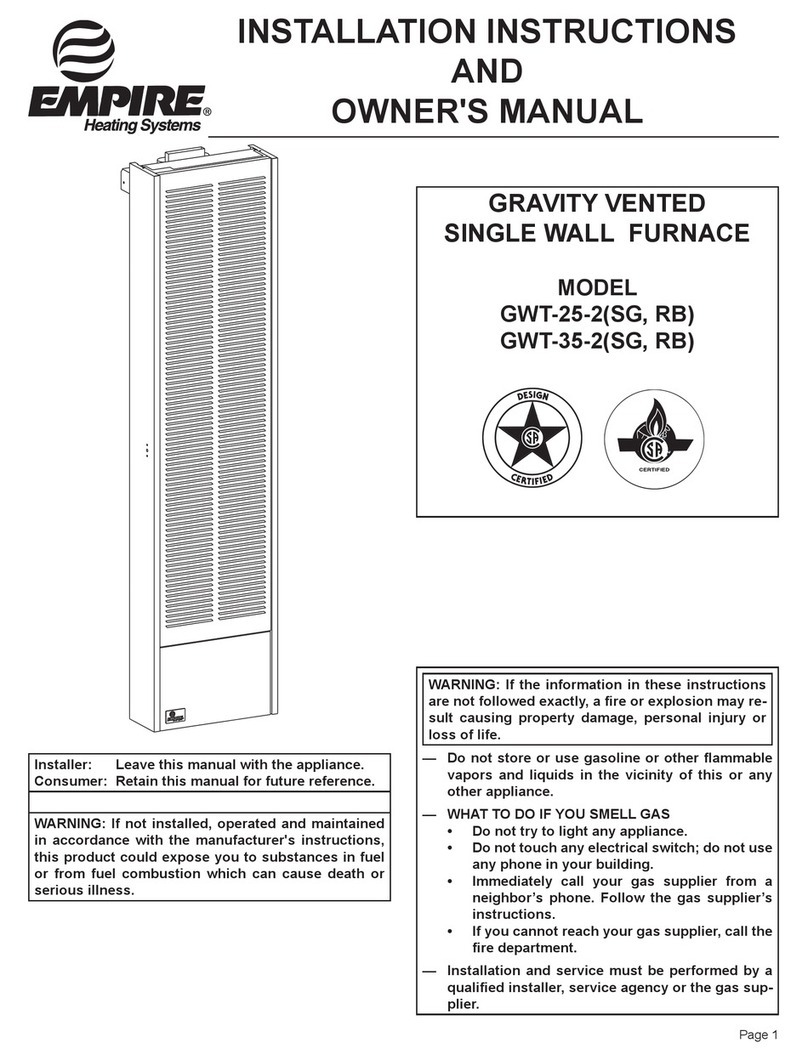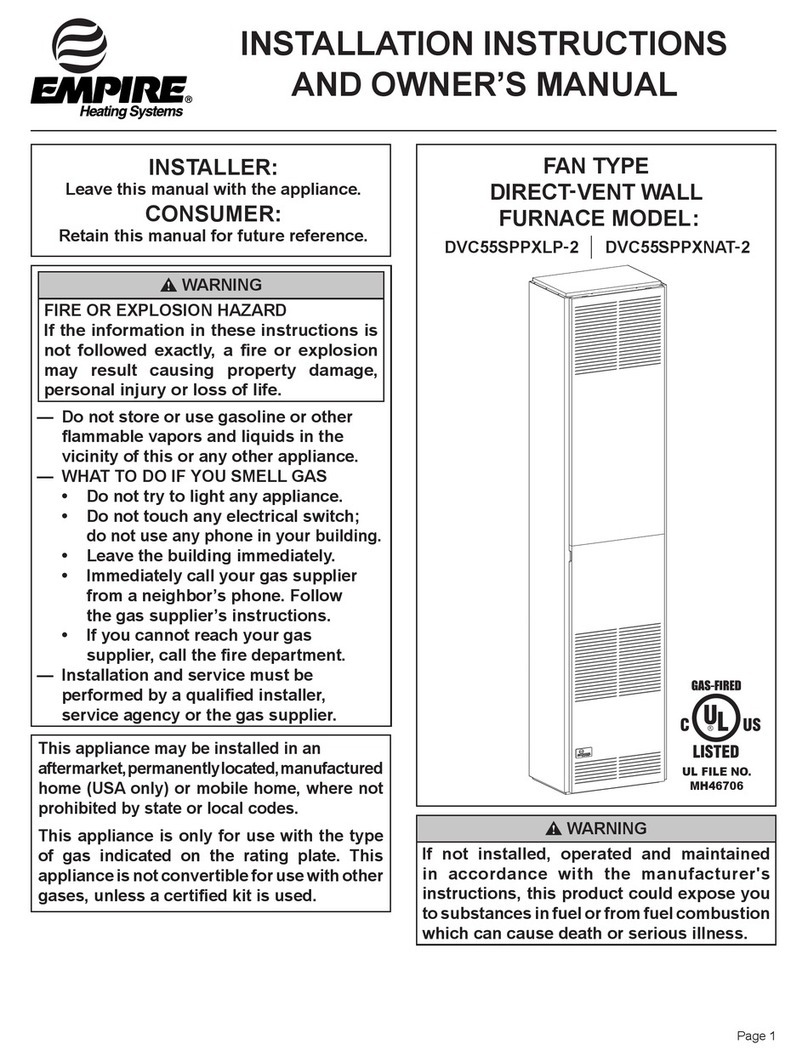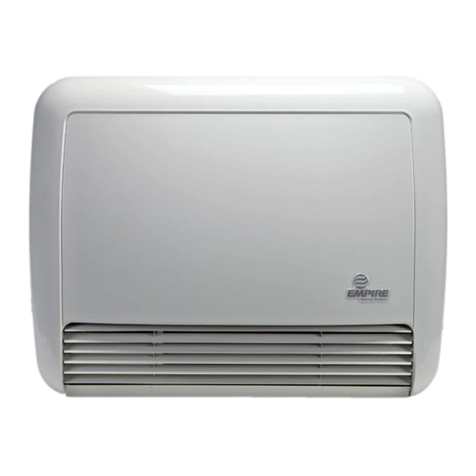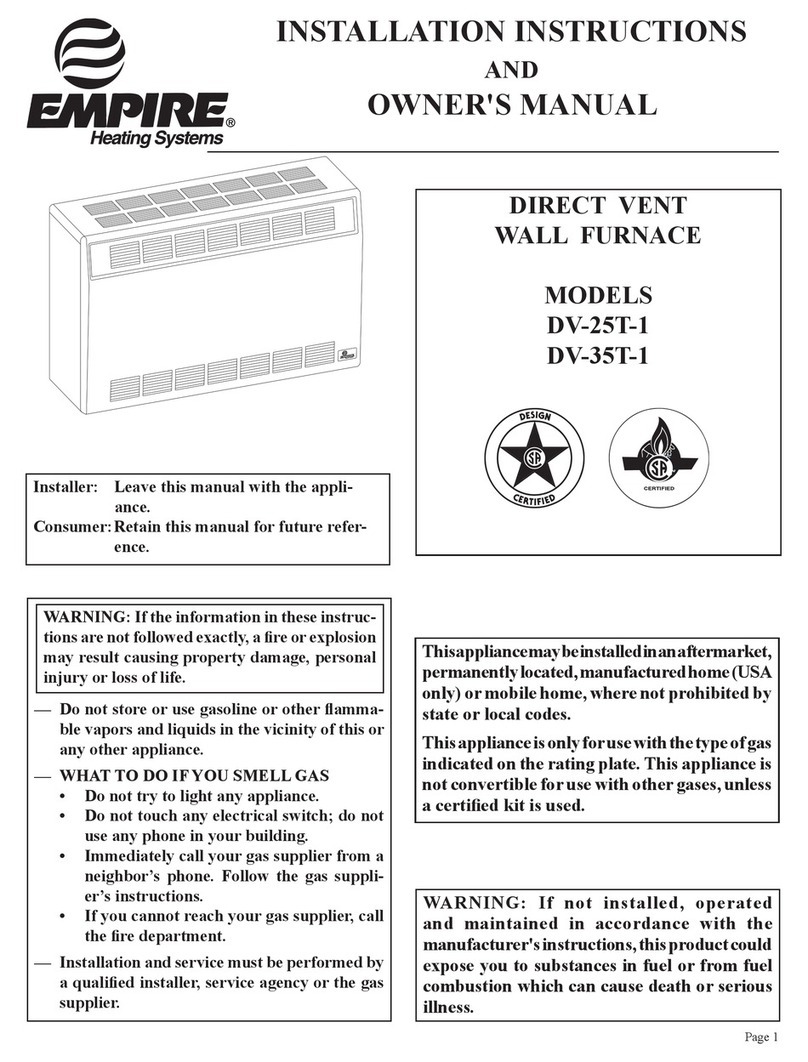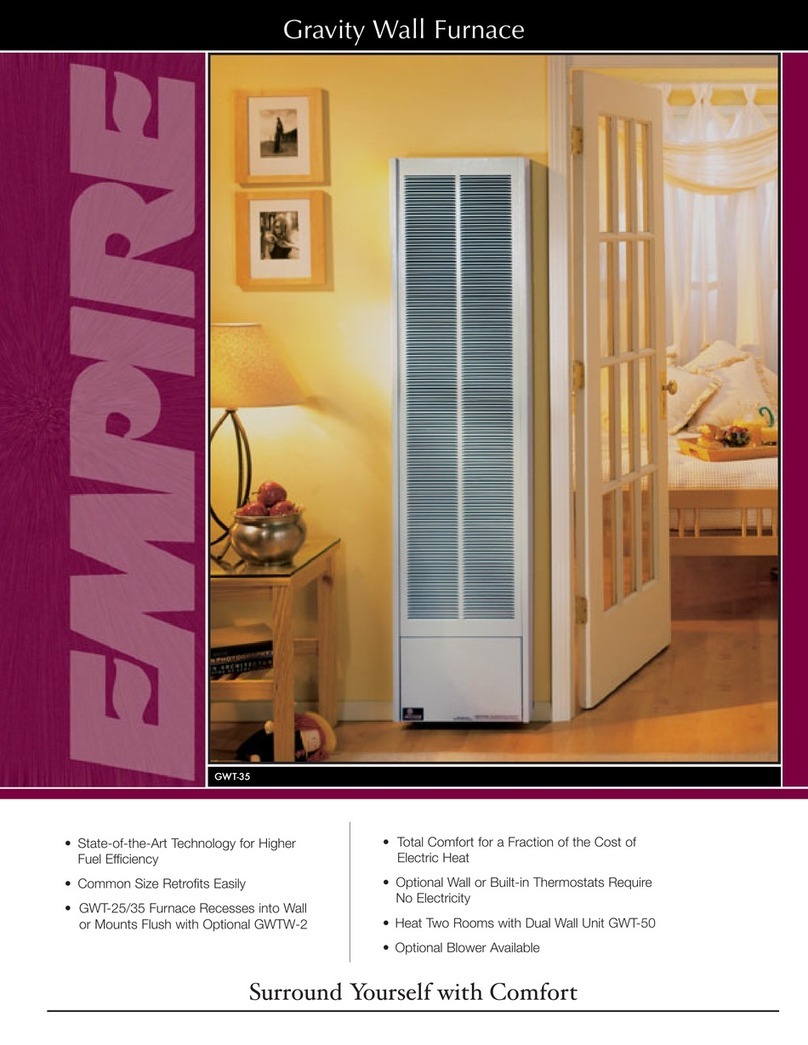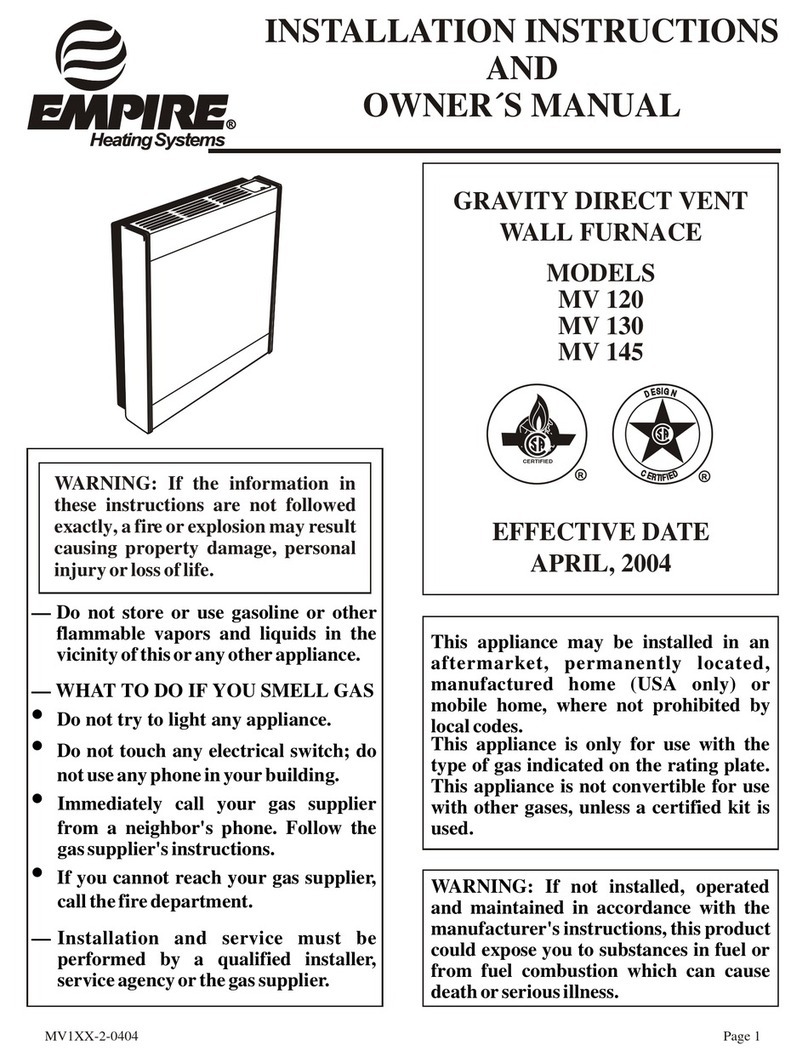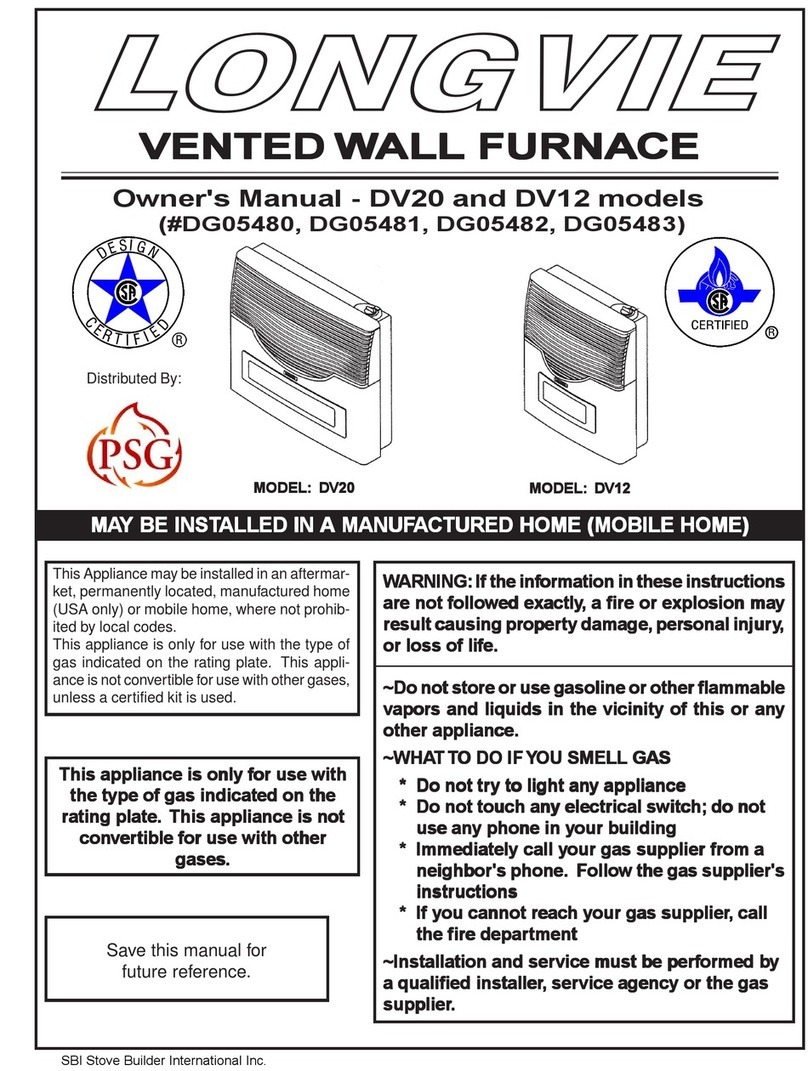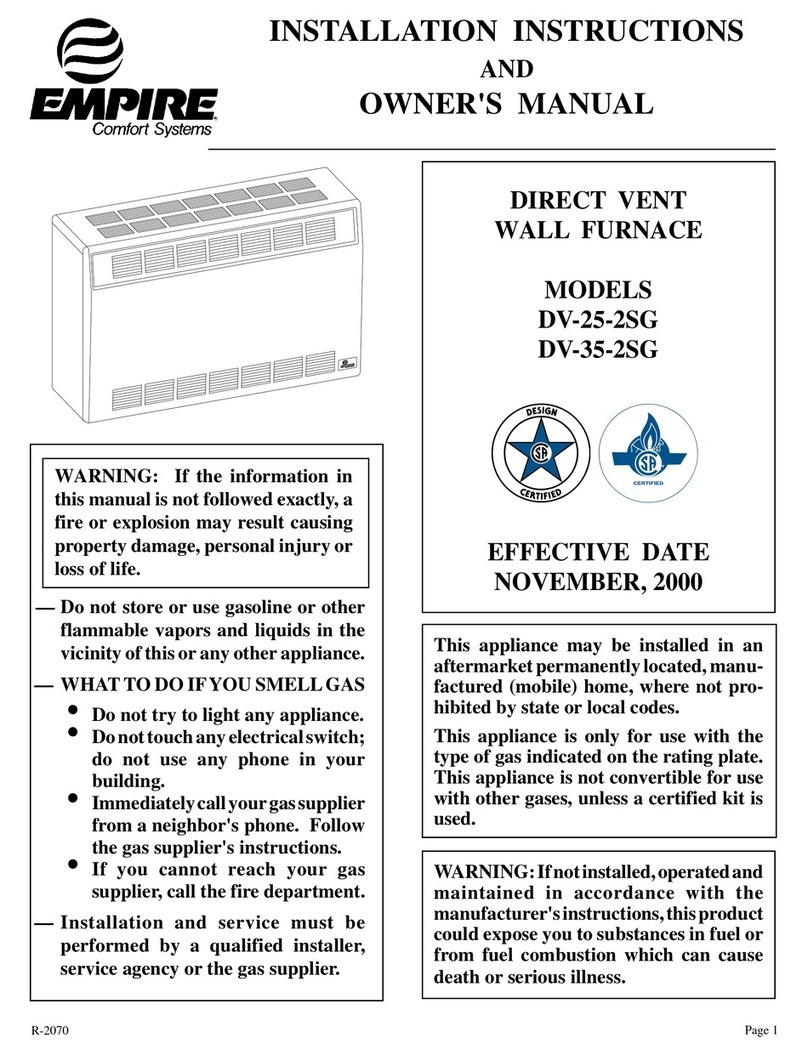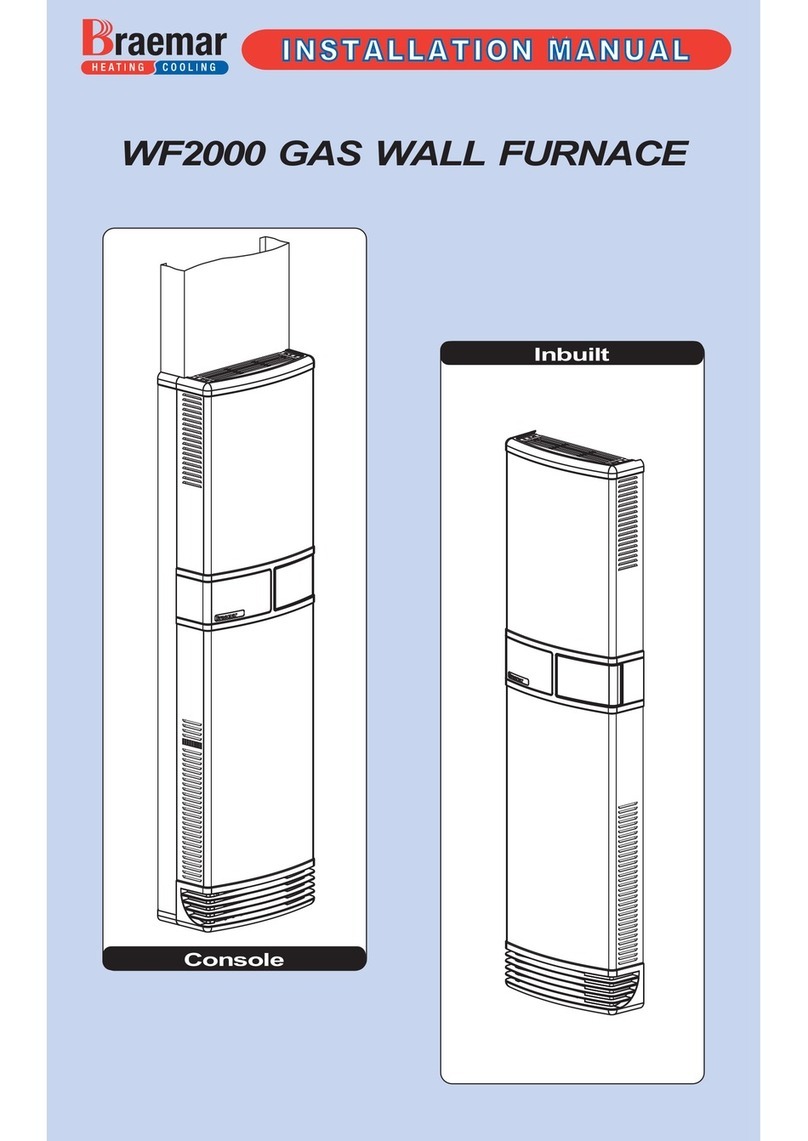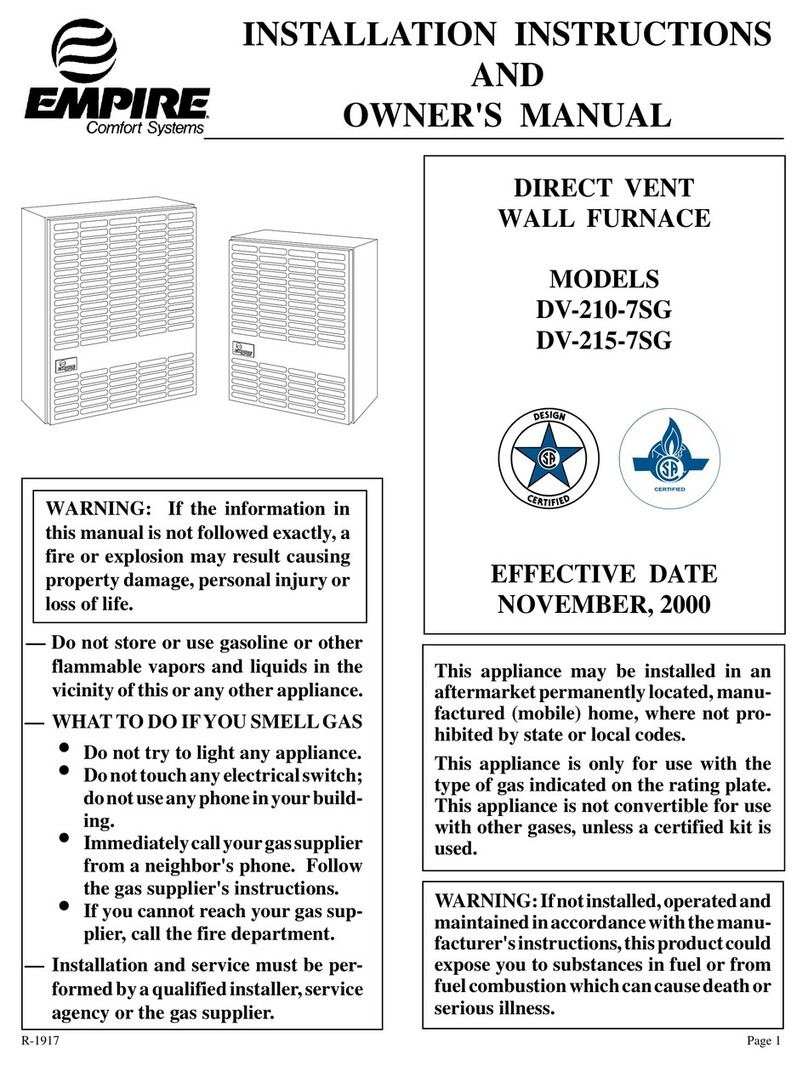
Installing Optional Side Outlets
Side outlet register, SOR-1 may be installed on one or both sides of the
furnaceattherequiredclearancesof18inches(457mm)toadjacentwall
or combustible material as shown in Figure 2.
1. Locateandcutthe51/2"(140mm)squareopeninginthecabinetside
using the template from the kit, exposing the inner liner knock-out.
2. Remove the knock-out.
3. Placetheregisteronthe51/2"(140mm)openingwiththelouversset
for the desired direction and mark the mounting holes using the
register as a template.
4. Drill (2) 1/8" (3mm) diameter holes in cabinet side and fasten the
register in place with (2) #10 x 1" (25mm) screws provided.
Side outlet kit, 10" (254mm) boot assembly with register, SOK-1 for
warm air discharge into an adjoining room may be installed on either
side of the furnace at the required clearance of 4 inches (102mm) to
adjacent wall as shown in Figure 3A.
1. Locateandcutthe51/2"(140mm)squareopeninginthecabinetside
using the template from the kit, exposing the inner liner knock-out.
2. Remove the knock-out.
3. Using the inner and outer boots as hole templates, mark and drill (8)
1/8" (3mm) diameter holes in the inner liner and cabinet side.
4. Using Figure 3A locate and cut a 6 3/4" (171mm) square opening
through walls.
5. Attach furnace to wall (see Attaching Furnace to Wall).
6. With furnace in place, after checking alignment of side outlet
opening in wall and furnace, place the 9 3/8" x 9 3/8" (238mm x
238mm) side outlet wall plate over outer boot, pass the outer boot
through the wall and attach side outlet wall plate to furnace side of
wall with (2) #10 x 1" (25mm) screws provided.
7. Fastenouterboottothecabinetsidewith(4)#8x1/4"(6mm)screws
provided.
8. Positionandattachinnerbootto inner liner with(4)#8x1/4"(6mm)
screws provided.
9. Locate the register with its louvers positioned for the desired air
discharge direction and mark the mounting holes using the register
as a template.
10. Drill(2)1/8"(3mm)diameterholesinthewallandfastentheregister
in place with (2) #10 x 1" (25mm) screws provided.
Installing Optional Rear Outlet
Rear outlet kit, 10" (254mm) boot assembly with register, ROK-1 for
warm air discharge into an adjoining room.
Attention: Before furnace is attached to the wall, the wall opening for
the rear outlet must be cut, in addition to removal of the outer and inner
casing knockouts on furnace.
1. Thewallopeningmeasurementsfortherearoutletarethefollowing.
A. From floor to bottom of wall opening is 14 3/4" (375mm).
B. From bottom of wall opening to top of wall opening is 8 1/2"
(216mm).
C. Wall opening width is 12 1/8" (308mm).
2. Remove outer casing knockout from outer casing back.
3. Remove inner casing knockout from inner casing.
4. Attach furnace to wall (see Attaching Furnace to Wall).
5. Align clearance holes on 8" x 14" (203mm x 356mm) boot with
screwholesonoutercasingbackandmarkboottobeflushwithwall
surface. Remove boot and cut to proper length.
6. Attach 8" x 14" (203mm x 356mm) boot to outer casing back with
(6) #10 x 1/2" (13mm) screws provided.
7. Align clearance holes on 6" x 10" (152mm x 254mm) duct with
screw holes on inner casing and mark duct to be 2 1/4" (57mm)
shorterthan 8" x14"(203mm x 356mm)boot. Removeduct and cut
to proper length.
8. Attach 6" x 10" (152mm x 254mm) duct to inner casing with (6) #10
x 1/2" (13mm) screws provided.
9. Insertrearregisterinto8"x14"(203mmx356mm)boot. Attachrear
register to wall with (2) #10 x 1" (25mm) screws provided.R-1584Page 4
Ventilation and Combustion Air
Wall furnaces shall be installed in a location in which the facilities for
ventilation permit satisfactory combustion of gas and proper venting
under normal conditions. In buildings of conventional frame, brick, or
stone construction without tight storm windows and doors, infiltration
is normally adequate to provide air for combustion and draft hood
dilution.
Where appliances are installed in confined and unconfined spaces
withinabuilding,the building beingofunusuallytightconstruction,air
forcombustionandventilationmustbeobtaineddirectlyfromoutdoors
or from such spaces that freely communicate with the outdoors. Under
these conditions, the confined and unconfined spaces shall be provided
withtwopermanentopenings, one near thetopoftheenclosureand one
nearthe bottom;eachopening shallhavea freeareaof notless than one
square inch (6.45cm2) per 2,000 BTU hr. (.6KW/H) of total input.
Qualified Installing Agency
Installation and replacement of gas piping, gas utilization equipment or
accessories and repair and servicing of equipment shall be performed
only by a qualified agency. The term "qualified agency" means any
individual, firm, corporation or company which either in person or
through a representative is engaged in and is responsible for (a) the
installationorreplacementofgaspipingor(b)theconnection,installation,
repair or servicing of equipment, who is experienced in such work,
familiar with all precautions required and has complied with all the
requirements of the authority having jurisdiction.
Theinstallationmustconformwithlocalcodesor,intheabsenceoflocal
codes, with the National Fuel Gas Code, ANSI Z223.1*/Canadian
Installation Code, CAN/CGA B149.
*Available from the American National Standards Institute, Inc., 11 West 42nd
St., New York, N.Y. 10036.
Clearances
1. In selecting a location for installation, it is necessary to provide
adequateaccessibilityclearancesforservicingandproperinstallation.
2. TheFAW-55 canbe attachedto the wall or recessedinto thewall up
to 4 inches (102mm) in depth.
3. The wall in which the furnace is recessed has (0) zero (0mm)
clearance to the furnace sides and top.
4. When using side discharge registers, SOR-1 or SOK-1, the furnace
cannot be recessed into the wall.
5. Clearance to sidewall or combustible material is 4 inches (102mm).
6. Ceiling clearance is 7 1/2 inches (191mm).
7. Floor and rear wall clearance is (0) zero inches (0mm).
8. Clearance of 18 inches (457mm) is required to adjacent wall or
combustiblematerialwhenflushmountedSOR-1,sideoutletregister
is used.
Before Installing Consider The Following Venting
1. Achimneyforresidential-typeorlow-heatgasutilizationequipment
shall extend at least 3 feet (914mm) above the highest point where
it passes through a roof of a building and at least 2 feet (610mm)
higherthananyportionofbuildingwithinahorizontaldistanceof10
feet (3m).
2. This furnace must not be connected to a chimney flue serving a
separate solid-fuel burning appliance.
3. Uninsulated Single-Wall Metal Pipe shall not be used outdoors
in cold climates for venting gas utilization equipment.
4. Attention! This Fan Type Vented Wall Furnace is equipped with a
vent safety switch. In the event of spillage of flue products due to
improper venting the vent safety switch will open, which results in
the main burners to "shut off".
Referto Figure1 and Page12 foradditional information regardingU.L.
Listed gas vent equipment.
